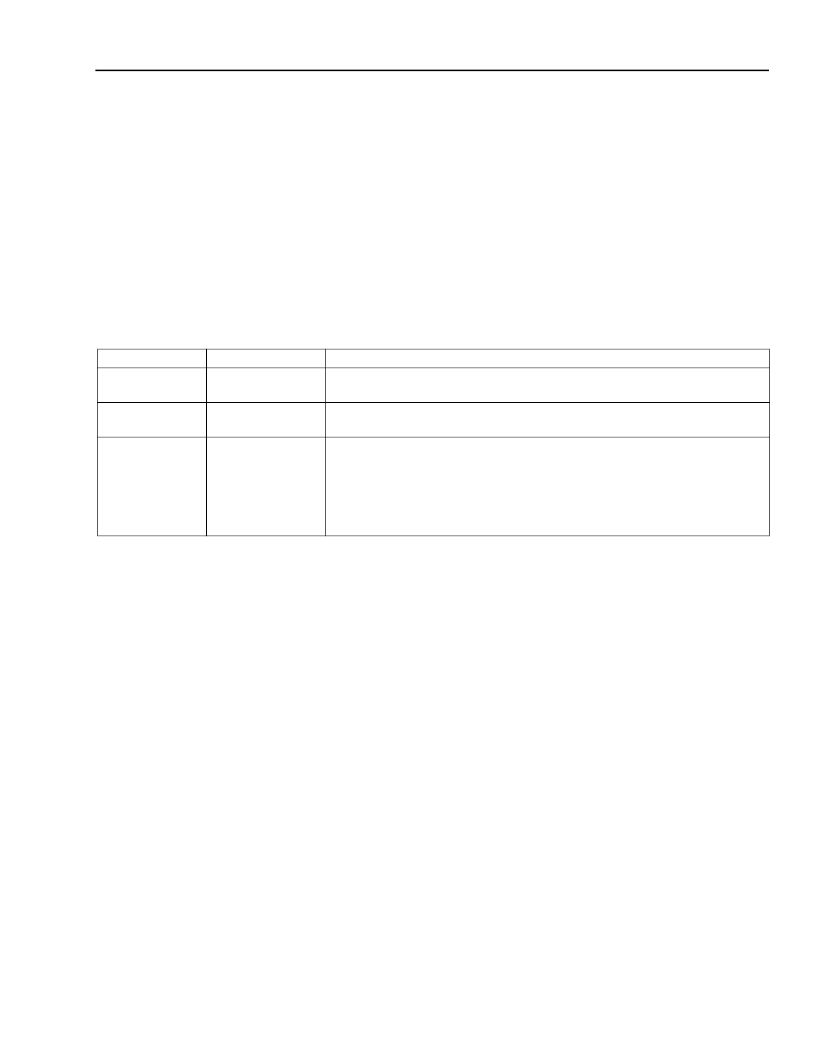- 您現(xiàn)在的位置:買(mǎi)賣(mài)IC網(wǎng) > PDF目錄383876 > T8531A (Lineage Power) Tone Processing(音調(diào)處理器件) PDF資料下載
參數(shù)資料
| 型號(hào): | T8531A |
| 廠商: | Lineage Power |
| 英文描述: | Tone Processing(音調(diào)處理器件) |
| 中文描述: | 音處理(音調(diào)處理器件) |
| 文件頁(yè)數(shù): | 9/20頁(yè) |
| 文件大小: | 338K |
| 代理商: | T8531A |
第1頁(yè)第2頁(yè)第3頁(yè)第4頁(yè)第5頁(yè)第6頁(yè)第7頁(yè)第8頁(yè)當(dāng)前第9頁(yè)第10頁(yè)第11頁(yè)第12頁(yè)第13頁(yè)第14頁(yè)第15頁(yè)第16頁(yè)第17頁(yè)第18頁(yè)第19頁(yè)第20頁(yè)

Lucent Technologies Inc.
9
User Manual
September 2000
T8531 and T8531A Tone Processing
Caller ID Generation
(continued)
Caller ID Generation Operation
The host performs the following actions prior to configuring the TX ac routine* control word for caller ID generation:
I
Writes the CID time-slot control number.
I
Writes the number of bytes to be transmitted.
I
Writes the caller ID message data.
Each caller ID message data word in DSP memory consists of 2 bytes, and the most significant one is transmitted
first. The algorithm supports message lengths up to 255 bytes. The caller ID generator control words address map
is shown in Table 6.
Table 6. Caller ID Control Words
The host is required to poll the time slot control number to decide if the caller ID control area is available for a new
control message. If the value returned is 0xFFFF, the host can write the control area. After initializing the control
area, the host may change the TX ac routine to the caller ID generation routine.
Example:
To send the following message "06/29 17:31 01 73" for time slot 2
, the host would write:
I
0x0080 to address 0x05F4.
I
0x000C to address 0x05FA.
I
0x3036 (month), 0x3239 (day), 0x3137 (hour), 0x3331 (minutes), 0x3031 (two digits of line number), 0x3733
(next two digits of line number) to addresses starting at 0x0900
.
I
0x1470 to address 0x0082.
Once the routine is set to caller ID, the algorithm begins transmitting the aforementioned modulated sequence.
Transmission continues until all data words plus checksum are transmitted. The routine can be shut off at anytime,
however, by writing TX or RX ac routines inactive. Upon transmission of all bytes, the caller ID routine automati-
cally changes the TX ac and RX ac routines to inactive. Therefore, the host can determine when all bytes have
been transmitted by polling the TX ac routine control word.
The caller ID generator shares memory with the call progress tone generator and DTMF detector. This means that
either call progress tone generation and/or DTMF should be finished prior to configuring the TX ac routine control
word for caller ID generation and vice versa.
* CID is started as a TX path routine but contains both a TX and an RX part.
The caller ID generator only sends the digits as shown above; the caller ID detector can add the "/" and the ":".
Caller ID detectors can accept a line number longer than the four digits shown in this example.
RAM Address
0x05F4
Size
Function
1 word, serves all
16 channels
1 word, serves all
16 channels
Sixteen 128 word
structures
CID time-slot control number: 0xFFFF corresponds to free data space.
The host can write data 0x0000, 0x0040, . . . 0x03C0.
Message length [value: 0x09—0xFF].
0x05FA
0x0800:0x087F
0x0880:0x08FF
.
.
.
0x0F80:0x0FFF
Per time-slot caller ID message data for time slots 0 through 15.
相關(guān)PDF資料 |
PDF描述 |
|---|---|
| T8532 | Multichannel Programmable Codec Chip Set(多通道可編程編解碼器芯片組) |
| T8534 | Quad Programmable Line Card Signal Processor(四通道可編程線卡信號(hào)處理器) |
| T8533 | Quad Programmable Line Card Signal Processor(四通道可編程線卡信號(hào)處理器) |
| T8535A | Quad Programmable Codec Chip Set(四通道可編程編解碼器芯片組) |
| T8536A | Quad Programmable Codec Chip Set(四通道可編程編解碼器芯片組) |
相關(guān)代理商/技術(shù)參數(shù) |
參數(shù)描述 |
|---|---|
| T8532 | 制造商:AGERE 制造商全稱(chēng):AGERE 功能描述:T8531A/8532 Multichannel Programmable Codec Chip Set |
| T8533 | 制造商:AGERE 制造商全稱(chēng):AGERE 功能描述:T8533/34 Quad Programmable Line Card Signal Processor |
| T85331G | 制造商:BITECH 制造商全稱(chēng):Bi technologies 功能描述:Thick Film Super Low Profile SIP Resistor Networks |
| T85331J | 制造商:BITECH 制造商全稱(chēng):Bi technologies 功能描述:Thick Film Super Low Profile SIP Resistor Networks |
| T8534 | 制造商:AGERE 制造商全稱(chēng):AGERE 功能描述:T8533/34 Quad Programmable Line Card Signal Processor |
發(fā)布緊急采購(gòu),3分鐘左右您將得到回復(fù)。